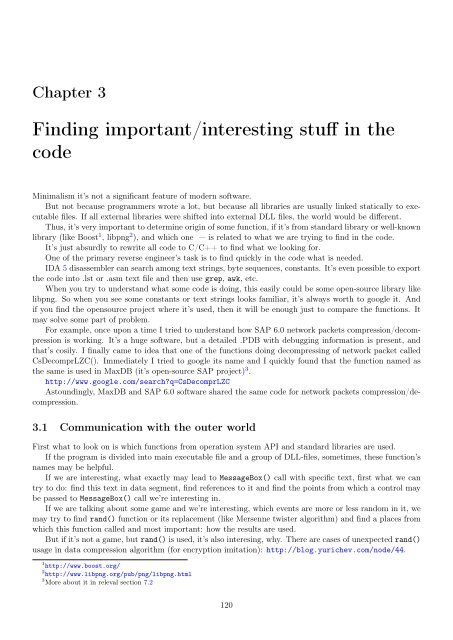Quick introduction to reverse engineering for beginners
Quick introduction to reverse engineering for beginners
Quick introduction to reverse engineering for beginners
Create successful ePaper yourself
Turn your PDF publications into a flip-book with our unique Google optimized e-Paper software.
Chapter 3<br />
Finding important/interesting stuff in the<br />
code<br />
Minimalism it’s not a significant feature of modern software.<br />
But not because programmers wrote a lot, but because all libraries are usually linked statically <strong>to</strong> executable<br />
files. If all external libraries were shifted in<strong>to</strong> external DLL files, the world would be different.<br />
Thus, it’s very important <strong>to</strong> determine origin of some function, if it’s from standard library or well-known<br />
library (like Boost 1 , libpng 2 ), and which one — is related <strong>to</strong> what we are trying <strong>to</strong> find in the code.<br />
It’s just absurdly <strong>to</strong> rewrite all code <strong>to</strong> C/C++ <strong>to</strong> find what we looking <strong>for</strong>.<br />
One of the primary <strong>reverse</strong> engineer’s task is <strong>to</strong> find quickly in the code what is needed.<br />
IDA 5 disassembler can search among text strings, byte sequences, constants. It’s even possible <strong>to</strong> export<br />
the code in<strong>to</strong> .lst or .asm text file and then use grep, awk, etc.<br />
When you try <strong>to</strong> understand what some code is doing, this easily could be some open-source library like<br />
libpng. So when you see some constants or text strings looks familiar, it’s always worth <strong>to</strong> google it. And<br />
if you find the opensource project where it’s used, then it will be enough just <strong>to</strong> compare the functions. It<br />
may solve some part of problem.<br />
For example, once upon a time I tried <strong>to</strong> understand how SAP 6.0 network packets compression/decompression<br />
is working. It’s a huge software, but a detailed .PDB with debugging in<strong>for</strong>mation is present, and<br />
that’s cosily. I finally came <strong>to</strong> idea that one of the functions doing decompressing of network packet called<br />
CsDecomprLZC(). Immediately I tried <strong>to</strong> google its name and I quickly found that the function named as<br />
the same is used in MaxDB (it’s open-source SAP project) 3 .<br />
http://www.google.com/search?q=CsDecomprLZC<br />
As<strong>to</strong>undingly, MaxDB and SAP 6.0 software shared the same code <strong>for</strong> network packets compression/decompression.<br />
3.1 Communication with the outer world<br />
First what <strong>to</strong> look on is which functions from operation system API and standard libraries are used.<br />
If the program is divided in<strong>to</strong> main executable file and a group of DLL-files, sometimes, these function’s<br />
names may be helpful.<br />
If we are interesting, what exactly may lead <strong>to</strong> MessageBox() call with specific text, first what we can<br />
try <strong>to</strong> do: find this text in data segment, find references <strong>to</strong> it and find the points from which a control may<br />
be passed <strong>to</strong> MessageBox() call we’re interesting in.<br />
If we are talking about some game and we’re interesting, which events are more or less random in it, we<br />
may try <strong>to</strong> find rand() function or its replacement (like Mersenne twister algorithm) and find a places from<br />
which this function called and most important: how the results are used.<br />
But if it’s not a game, but rand() is used, it’s also interesing, why. There are cases of unexpected rand()<br />
usage in data compression algorithm (<strong>for</strong> encryption imitation): http://blog.yurichev.com/node/44.<br />
1 http://www.boost.org/<br />
2 http://www.libpng.org/pub/png/libpng.html<br />
3 More about it in releval section 7.2<br />
120


